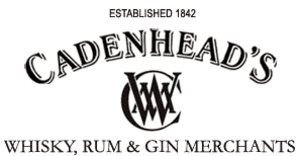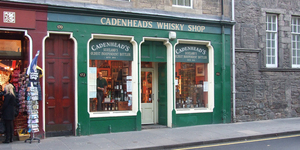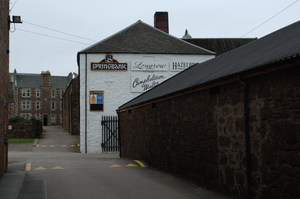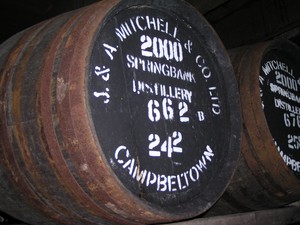|
|
Release Notes
Fully matured in bourbon barrels, this 10yo Irish whiskey is fruity on the nose with notes of mango, papaya and coconut. This develops into notes of cream soda, juicy plums and a hint of molasses to finish.
Cadenhead's
3rd Party Tasting Notes
Nose: Mango, papaya, earthy, coconut
Flavour: Cream soda, tangy, plums, vanilla oak
Finish: Dried banana, sourdough bread, almonds, hay and hints of molasses.
Flavour: Cream soda, tangy, plums, vanilla oak
Finish: Dried banana, sourdough bread, almonds, hay and hints of molasses.
Cadenhead's
The Bottler: Cadenhead
| Established: 1842 |
| Silent since: False |
| Address: Campbeltown, Argyll PA28 6HZ |
| → website |


The firm of William Cadenhead Ltd, Wine and Spirit Merchants, was founded in 1842 and is Scotland's oldest independent bottler. The company was was in the ownership of the same family until taken over by J & A Mitchell & Co.Ltd in 1972, the proprietors of Springbank distillery.
For 130 years prior to this, the firm of William Cadenhead Ltd traded from the same premises in the Netherkirkgate, Aberdeen. It was what subsequently became number 47 that Mr George Duncan established himself as a vintner and distillery agent. The business prospered and in little over 10 years he was joined by his brother-in-law Mr William Cadenhead. In 1858 Mr Duncan died following a short illness. William Cadenhead acquired the business and changed the trading name to that of his own. Whilst not much is known of George Duncan, a great deal is on record about his brother-in-law. It must be said that this is not because of his distinction as a vintner but because he was a local poet of renown throughout the Victorian era. Born in 1819, he began working at an early age in a small thread factory where he gained a great deal of respect from his employer. From there he became an overseer in the yarn sorting department of Maberly & Co at their Broadford works, now Richards PLC. About 1853 he left the company and joined his brother-in-law as traveller for Cadenhead's until Duncan's death in 1858 where he acquired the business. Apart from his enviable reputation as a poet, he became a prominent citizen taking part in all aspects of local affairs during his long life.
Early on Sunday morning, 11 December 1904 William Cadenhead died. He was succeeded in the business of Wine and Spirit Merchants at 47 Netherkirkgate by his nephew Robert W. Duthie. He was a quiet unassuming man, unlike his uncle, but developed what the firm became most famous for, namely single malt Scotch whisky and Demerara Rum. He advertised extensively on the back of buses, theatre curtains, concert programmes and in much else under the slogan 'By test the Best'. In addition Mr Duthie developed Cadenhead's brand whiskies, the de-luxe blend Putachieside and the more plebeian name The Heilanman.
In 1931 in the depth of the depression, the business of William Cadenhead was not in good shape financially. Mr Duthie was on his way to a meeting with his bank manager when he was unfortunately run over by a tram car whilst crossing the street. Duthie was a batchelor but left two sisters who knew nothing about the Wine and Spirit trade but were determined that the name of William Cadenhead should survive. Responsibility was handed over to a long term employee, Miss Ann Oliver, an eccentric lady who ran the business exactly as she wanted, refusing to move with the times. However, administration was lax and several bad decisions were made during this time forcing Ms Oliver to retire and sell the business.
Both the bonded and duty paid warehouses were full from the roof to the cellars of stock, the value of which no-one knew nor for which there were any records. In the end Christie's who had liquidated considerable stocks of rum were contacted. The result was a two-day sale of the entire stock and was at that date the largest sale of wines and spirits ever held in Great Britain. The sale took place in London on 3rd and 4th of October 1972 and although there were many bargains, on the whole it was most successful and contrary to expectations it resulted in a six figure surplus over liabilities for the firm.
Thereafter the goodwill, premises etc. of the firm William Cadenhead were sold to J & A Mitchell & Co Ltd., proprietors of Springbank Distillery, one of Scotland's oldest distilleries still owned by descendants of its founder. The name of Cadenhead is now a household name in the whisky world, and the present owners have expanded the Cadenhead business whilst still keeping the goals and traditional methods the firm began with in 1842.
For 130 years prior to this, the firm of William Cadenhead Ltd traded from the same premises in the Netherkirkgate, Aberdeen. It was what subsequently became number 47 that Mr George Duncan established himself as a vintner and distillery agent. The business prospered and in little over 10 years he was joined by his brother-in-law Mr William Cadenhead. In 1858 Mr Duncan died following a short illness. William Cadenhead acquired the business and changed the trading name to that of his own. Whilst not much is known of George Duncan, a great deal is on record about his brother-in-law. It must be said that this is not because of his distinction as a vintner but because he was a local poet of renown throughout the Victorian era. Born in 1819, he began working at an early age in a small thread factory where he gained a great deal of respect from his employer. From there he became an overseer in the yarn sorting department of Maberly & Co at their Broadford works, now Richards PLC. About 1853 he left the company and joined his brother-in-law as traveller for Cadenhead's until Duncan's death in 1858 where he acquired the business. Apart from his enviable reputation as a poet, he became a prominent citizen taking part in all aspects of local affairs during his long life.
Early on Sunday morning, 11 December 1904 William Cadenhead died. He was succeeded in the business of Wine and Spirit Merchants at 47 Netherkirkgate by his nephew Robert W. Duthie. He was a quiet unassuming man, unlike his uncle, but developed what the firm became most famous for, namely single malt Scotch whisky and Demerara Rum. He advertised extensively on the back of buses, theatre curtains, concert programmes and in much else under the slogan 'By test the Best'. In addition Mr Duthie developed Cadenhead's brand whiskies, the de-luxe blend Putachieside and the more plebeian name The Heilanman.
In 1931 in the depth of the depression, the business of William Cadenhead was not in good shape financially. Mr Duthie was on his way to a meeting with his bank manager when he was unfortunately run over by a tram car whilst crossing the street. Duthie was a batchelor but left two sisters who knew nothing about the Wine and Spirit trade but were determined that the name of William Cadenhead should survive. Responsibility was handed over to a long term employee, Miss Ann Oliver, an eccentric lady who ran the business exactly as she wanted, refusing to move with the times. However, administration was lax and several bad decisions were made during this time forcing Ms Oliver to retire and sell the business.
Both the bonded and duty paid warehouses were full from the roof to the cellars of stock, the value of which no-one knew nor for which there were any records. In the end Christie's who had liquidated considerable stocks of rum were contacted. The result was a two-day sale of the entire stock and was at that date the largest sale of wines and spirits ever held in Great Britain. The sale took place in London on 3rd and 4th of October 1972 and although there were many bargains, on the whole it was most successful and contrary to expectations it resulted in a six figure surplus over liabilities for the firm.
Thereafter the goodwill, premises etc. of the firm William Cadenhead were sold to J & A Mitchell & Co Ltd., proprietors of Springbank Distillery, one of Scotland's oldest distilleries still owned by descendants of its founder. The name of Cadenhead is now a household name in the whisky world, and the present owners have expanded the Cadenhead business whilst still keeping the goals and traditional methods the firm began with in 1842.
from Cadenhead
The Owner: Springbank
| Established: 1828 |
| Silent since: False |
| Address: 85 Longrow, Campbeltown PA28 6EX, United Kingdom |
Springbank Distillery is one of the last surviving producers of Campbeltown Single Malts. The distillery, located on the southern Kintyre peninsula, produces three distinct types of single malt Scotch whisky. These are branded as Springbank, Longrow and Hazelburn Single Malt. Springbank itself is the most popular variety, a two and a half times distilled non-chillfiltered single malt. Longrow is a highly peated single malt available in Bourbon, Sherry and an experimental Tokaji cask maturation. Hazelburn has only been produced at Springbank since 1997, is fully triple distilled and comes in a 8yo and 12yo variety.
2000 - The 10yo official bottling that hadn"t been available for a number of years is re-launched. This was roughly around the same time Signatory dropped of my shopping list; the price difference with the old 21yo was minimal. In the same year the first official bottling or Longrow with an age statement is released; the Longrow 10yo.
In the new Millenium
2008 - Early in the Summer some shocking news starts to leak out about the imminent mothballing of the Springbank distillery - at least for part of the year. Part of the staff is laid off because Springbank would produce significantly less whisky than usual in 2009. From what I understand, the Glengyle distillery will be closed as well. Apparently, the owners felt that they had sufficient whisky stocks for now. That"s a little odd, because for many years they claimed that they could keep raising their prices because they didn"t have enough stocks to satisfy demand anyway.
2005 - The first official bottling of Hazelburn is released with an age statement of eight years.
I"ve had the pleasure of sampling some fabulous older Springbanks, but by the time I had grown really mad about single malts, most of the "better" expressions were already priced well outside my financial comfort zone. So, Springbank never grew into a real favourite of mine, although the 21yo that was available at the end of the 1990"s (pictured above) was fantastic. Better yet, it was relatively modestly priced at less than 100 guilders.
Unlike its previous owner, the Glen Scotia distillery has managed to survive to this day. For many years it was the only remaining Campbeltown distillery, apart from their neighbours at Springbank of course. In fact, for a few years the relations between Springbank and Glen Scotia were extra neighbourly because a crew from Springbank came over to the Glen Scotia distillery every now and then to produce a little whisky (to keep the equipment in shape).
For many years the owners of Springbank claimed they could set such steep prices for their whisky because they didn"t have enough stocks to satisfy demand anyway. In such a (financially comfortable) climate it is hardly surprising that they (sort of) reconstructed the old Glengyle distillery a few years ago so they could increase production capacity. Unfortunately, a few years later the economical winds changed; Springbank & Glengyle were (temporarily) closed.
Even at that time, most Springbanks were released as expensive "ultra premium" bottles. As a result, a lot of them were exported to the USA - the country where massclusivity was invented and where many customers are sensitive to status. Or rather: the perception of status - which in turn is often linked to the price that has to be paid for certain products. America is not unique in that respect though - these misconceptions exist elsewhere too.
2010 - At the end of the 1990"s and during most of the noughties the prices for Springbank official bottlings were much higher than those for other, comparable single malt whiskies. After the brief mothballing of the distillery, their prices seemed much more in line with other Scotch single malts. (Or rather: most other brands had caught up ;-)

2009 - Springbank resumes part-time production again; 3 months of malting followed by 3 months of distillation.
Three years later in 1828 Springbank was built on the site of the older Archibald"s illegal still.
The quality of Springbank whisky became well enough known for in 1838 a certain John Walker of Kilmarnock to buy, in 1838, 118 gallons at 8s 8d (43p) a gallon.
The Mitchells first came to Campbeltown in the mid 17th century as settlers from the lowlands, some of whom were already maltsters. The story of Springbank begins a century later with the great-grandfather of the distillery"s current managing director. Archibald Mitchell, the son of a farmer married a cousin and learnt from his father-in-law (and uncle!) the art of malting. He also later acquired the art of distilling, though never the one of buying a licence. It was his sons Hugh, Archibald, John and William plus daughter Mary who took up distilling as a legal pursuit.
The first venture was Rieclachan Distillery in 1825 in which Archibald the younger was an original partner, and he was soon joined by Hugh.
Springbank is one of only two distilleries in Scotland to perform every step in the whisky making process, from malting the barley to bottling the spirit, on same premises: the other is Kilchoman Distillery who also grow their own barley. While a few others still maintain the first step in the process, the malting of barley (which is becoming more rare), Springbank also bottles their own whisky. The distillery is also one of the most inactive, having stills operating less than a third of the time.
Springbank is one of the few remaining family owned distilleries. Perhaps it is for this reason that nearly all of its whisky is sold as a single malt, with little of it finding its way into blends. Most blends are produced by larger conglomerates who tend to use the single malts from the distilleries that they own in their blends. Springbank produces two of its own blends, 5 year old Campbeltown Loch, and Mitchell"s 12 year old.
As distillery after distillery set up in Campbeltown, with the demand for malts from this area appearing insatiable, the business of the Mitchell family stretched further. John bought out the Toberanrigh Distillery built by cousin Alexander Wylie, while his sister Mary built Drumore Distillery in 1834 and William founded Glengyle in 1872.
Already in the late nineteenth century, Campbeltown whisky was of the highest quality and in enormous demand by blenders. Before the turn of this century it was highly peated and only short of being Islay in style. In the early part of this century the fashion in whisky moved away from these heavier types of whisky and Springbank altered accordingly, with malt being dried over coal rather than peat.
Barnard"s Campbeltown was a very different town from today"s, though. During the glory days of the town and the tip of the Kintyre peninsula, more that thirty distilleries were active in the area. Campbeltown was also known as "The Whisky Capital of the World". However, most of the distilleries were focused on quantity rather than quality because they were not able to keep up with the demand for their malt whiskies (especially from the US) anyway. So there was no incentive to try and improve the Campbeltown whiskies...

This attitude came back to haunt the Campbeltown distillers when Western economies were hit by an international recession after World War I and the prohibition in the USA brought (legal) exports to the America"s to a virtual standstill. One of the first victims was the Glengyle distillery, built circa 1873 by William Mitchell after a fight with his brother John at Springbank. The distillery closed down again in 1825 - and many other Campbeltown distilleries followed. The economical downturn proved to have disastrous consequences for the "volume" whisky distilleries in Campbeltown. The owner of the Glen Scotia distillery became so depressed that he drowned himself in the artificial lake that was constructed as the distillery"s water supply. Some people say his ghost still haunts the buildings...
Whisky is liquid courage. Many people - mostly men - have performed acts of inspired bravery (and foolishness) whilst under the influence of "the water of life". And while the cheaper blends and bourbons usually affect the more primitive parts of the brain (truncus cerebri), it seems single malts often appeal to the higher brain functions in the cerebrum.
So, while the symptoms of low budget alcohol abuse often include primitive behavior like shouting and brawling, those of us that prefer to abuse our alcohol in style find ourselves inspired to start writing books, composing music or plan a voyage to Scotland where the whisky was made. Travellers that have the time and means to stay for a few days can visit all the main whisky producing regions and one of its distilleries.
However, from a traveller"s perspective, visiting the Campbeltown area is a small nightmare. One has to make a long trek to the Southern tip of the Kintyre peninsula on the Western coast of Scotland to reach Springbank - or the nearby Glen Scotia distillery. Except for the distilleries, there"s not much happening in Campbeltown. And even for the people that want to "get away from it all" for a few days, Springbank is a fairly poor destination. It"s one of the few distilleries that isn"t surrounded by the lush Scottish countryside - located in the middle of a busy town.
Many distilleries welcome visitors with open arms, but when some of the maniacs visited Springbank in 2005 they didn"t seem very pleased to see us - or the other visitors for that matter. So, for me the best thing of the trip was the night I spent in the same hotel that Alfred Barnard stayed in when he visited the area over a century ago.
With the success of a nearby coal mine, fuel to run the distilleries was plentiful and cheap. And profits for the distillers were handsome. All the major distilling dynasties in the town, the Colvilles, Mitchells, Mactaggarts and Fergusons built large gentlemen"s houses in keeping with the money pouring into the bank accounts and the newfound status of respectability they had acquired. By 1891, Campbeltown with a population of just 1,969 was reputed to be the richest town per capita in Britain.
But every bubble bursts. And in the 1920s, with one or two notable exceptions, distillers in the town had begun cutting corners in the making of their whisky to meet the demand.
Soon blenders began to turn their backs on Campbeltown and looked for consistently better malt elsewhere. Only Springbank, Glen Scotia and Rieclachan maintained their quality and their order books open as one by one the other distilleries fell by the wayside.
In 1934 it was decided to close Rieclachan, leaving only Springbank and Glen Scotia, as is the case today.
Trivia:
- Springbank distillery was built in 1828 by two brothers, Archibald and Hugh Mitchell. Rumour has it that their father had already been running an illegal distillery at the same location for years. The Springbank distillery is still owned by the Mitchell family - and so is the (sort of) reconstructed Glengyle distillery.
- Apart from the "Springbank" brand the distillery produces two other "deluxe" brands, Hazelburn and Longrow.
- Frank McHardy has been working at the distillery for many years; Helen Arthur"s guide from the 1990"s already lists him as distillery manager and he was still involved with Springbank when it (temporarily) closed down in 2008. url="http://www.springbankdistillers.com"
from Wikipedia, Malt Madness
